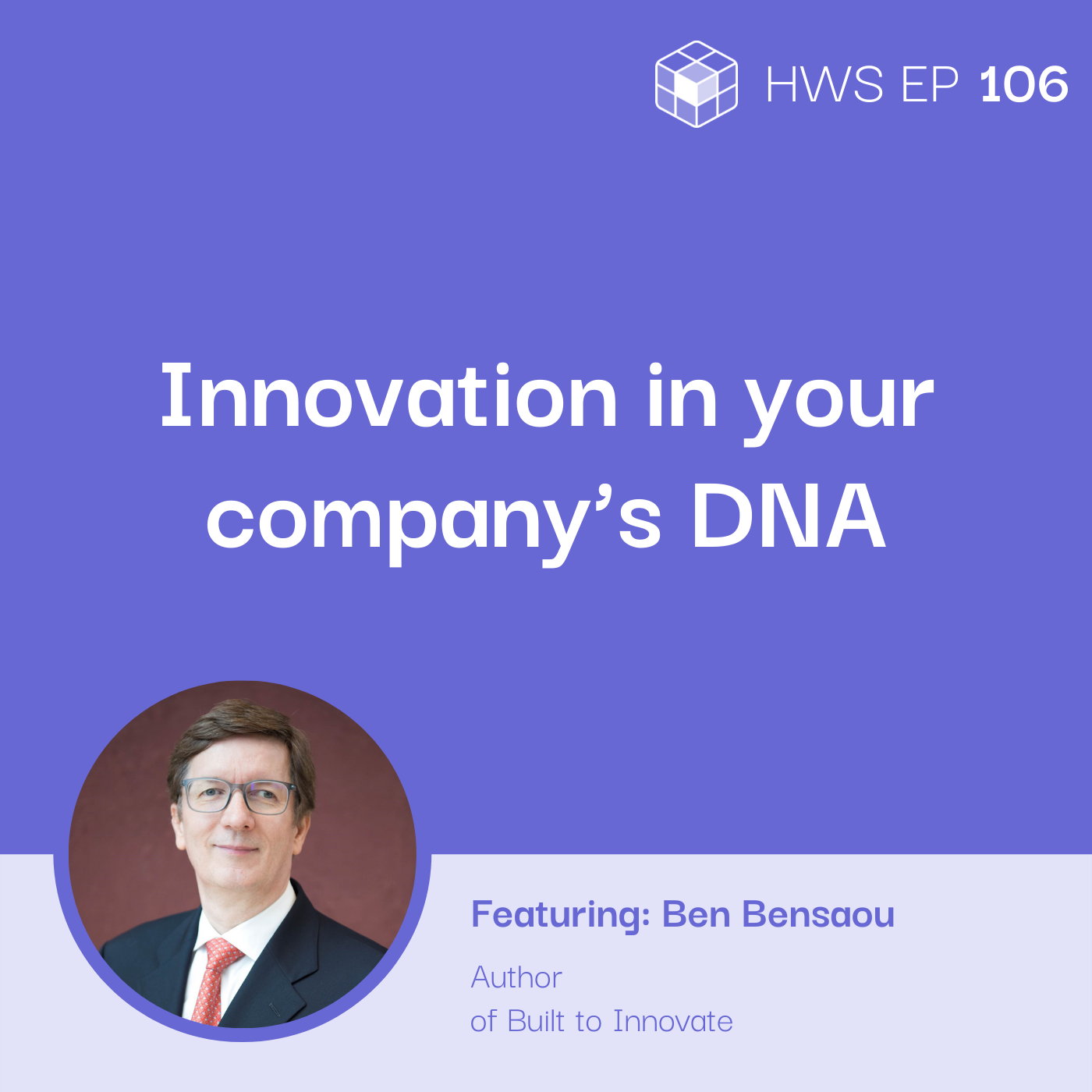Listen on:
Table of Contents:
Problem: How do you wire essential innovation practices into your company’s DNA?
Companies always seem to be at the startup stage or need a genius leader to be innovative. Ben Bensaou, the author of Built to Innovate, disagrees with that assumption. During the course of his research, he learned that established companies, even century-old ones, can innovate. But how do companies wire essential innovation practices into your company’s DNA?
You can innovate in everything you do, not just in your products and your technologies, but also in your services and your processes. It’s very important that innovating becomes a habit, and this is how it gets into your DNA.”
Practice Makes Perfect: Make Innovation a Habit
Ben encourages businesses to slowly develop innovative habits, even though this is hardwired into your company’s system. It’s like going to the gym, where one makes small, sustainable progress, training the muscles little by little.
Innovations don’t have to be massive improvements. Small changes can be incorporated into existing processes. To have a significant impact, these small initiatives should be practiced regularly.
So it can be as simple as getting people to spend some time with a customer, just go around streets and look at your customer. And then you have to basically get a few simple tools to learn how to listen to the voice of the customer. Also listen to the silence of the customer, the things that the customers don’t tell you. And then also learn how to listen to non-customers. It can be very simple. It doesn’t have to be a very sophisticated process. And then if people do this on a regular basis. Then, just like the metaphor says, they will strengthen their innovation muscle. It’s just like a muscle. You just have to train it every day. And the more you practice, the better you get.”
Switch from Selling Mindset to being Emphatic
Encourage your team to think of product development not as an avenue to sell solutions, but to really understand the customers’ journey. First, switch your team’s mindset. Pivot from an execution mindset, which is trying to sell your customer’s solution. Take time to understand their experiences. Think of it as a journey of discovery, as if your customers are trying to hide something from you, and you have to find what it is.
You have to ask silly questions and pretend you don’t know anything. You know, very well, but you just have to do this is. Exactly how you have to behave when you’re trying to listen to the silence of the customer base. Because if you call them, and you have your certainties, and you say, “Oh, I understand your problem”. Then actually people will, not even talk to you. They will expect that you’re trying to sell something. The word empathy is very important.”
Do Your Best to Understand Your Customers
Ben shared the story of how appliance company Philips practices innovation. The company regularly exercise innovation projects. Part of this requires employees to live with customers. Since Philips design home appliances, this allows them to experience their customer’s daily life. In one of these activities, some employees noticed how people scoop out limescale from their teacups after pouring in water. This simple activity led them to come up with a mouse filter, that small triangle net in your kettle that gets these lime scales out of the drink. To achieve this, Philips did the following:
- Filter the message from the customer’s silence. Find out what they’re saying from the non-verbal signals that they give.
- Map the life of the customer. If you need to shadow and stay with them, do so. It’s important for you to experience their actual pain points.
This is an example of what I call listening to the silence of the customer. And for this, you need to have a very systematic approach. You have to try to understand what are the steps in their life. For instance, if you’re going to use a kettle, what happens before you use it? What happens after you use it? So, you have to create like a process map of what happens to the life of the customer. This is very important, before and after, and then you observe. You take pictures, you do videos. You try to live the life of the customer.”
Formalize Innovative Engines
Many companies, especially large corporations, have efficient execution engines, but not all formalize innovation engines. Employees need to feel safe and comfortable engaging in innovation. It is crucial that they have a structure they can rely on for sharing ideas with the team, or for providing suggestions that can help improve a project.
You can imagine many companies have a very efficient execution engine, and it’s very structured. It has a governance structure. It has processes, and it has a culture. So, what I’m talking about when embedding the DNA innovation, you have to formally create what I call an innovating engine. And it has to have an infrastructure. It has to have processes, and it has to have a culture.”
The Three-Step Process
To create these infrastructures and structures for innovating, Ben shares these three, critical processes that you can integrate into your existing ones.
Step # 1 Creating Ideas
It’s important to get everybody on board, from the leaders to the frontline people who face the customer every day. To achieve this, you need to create a work environment that normalizes and encourages employees to:
- Become the ambassadors for innovation, especially the top management.
- Create a support structure for middle managers, one that will empower them to nurture innovative ideas from the entry-level team members.
- Build platforms where teams can talk about their problems, solutions, and ideas.
And then they did something fantastic, a fantastic support system for middle managers. Because you see middle managers, they’re not specialists in innovation. They have people in their team who want to innovate, and they don’t know what to do. So, they created a support structure for these people. If I’m correct, between 2016 and 2020, they trained and certified a thousand innovation coaches, which were locally activated across the whole company. If they had an individual person or a team who wanted to innovate, they would know what to do and whom to call upon. These innovation coaches at the local level, you can find them anywhere. It gives you a sense of the role of the middle managers, especially in the integrating process.”
Connect Ideas and Remove Silos
Then you need to connect these ideas. You need to have people to connect the innovators together and for an unsiloed network. In some cases, some teams use a stage-gate process to move the ideas from, something that is selected to become a funded prototype. Then, moved to the execution engine to be implemented. It’s about closing the gap between your teams and between your sales team and your customers.
So what they do is that they create, they call it a win-win partnership. Where they take their scientists and their salespeople together. They go to the customer because the salespeople don’t necessarily know what this technology can do. So, when they go together with the scientists, they discover problems that the customers didn’t know what they could solve for them. So, this is a very important thing. You have to create this space where you close the gap between your innovators and your salespeople, but also between your innovators and the customers.”
Reframing Your Mindset
Reframing means challenging the orthodoxies, challenging the status quo. And this is a process where everybody has to be involved. Ben encourages companies to take a hard look at challenging basic assumptions about the companies shared view of the mission, the customers, and the overall definition of the organization. Getting everyone to participate enables you to grow and think about boundaries your team is willing to cross.
If you don’t expand the mission, or what the company is about, things won’t happen. Now, this might speak to you. A lot of companies are broadening the innovation agenda. They’re putting the agenda squarely on innovation, but they’re broadening the task to include digital transformation for them. So, they’re saying digital transformation is part of the new mission or sustainability is part of the mission. It’s the responsibility of the board to, reframe the mission for the company.”
Encourage, Recognize and Incentivize
Innovation needs to start from the top. The leaders need to give the green light for innovation. And by green light, it’s more than a verbal commitment. Your team needs infrastructure, tools, and leaders who will guide them in the process. Most importantly, you need to create a culture that encourages, recognizes, and incentivizes innovators.
I repeat all the time that if you don’t give them permission, they won’t innovate. They’ll do their job and that’s all. So, they need to have permission from the highest level that they should innovate. They need to be capable. You need to give them tools. I mean, they know how to do that. They know how to do their job. They have been trained for that, but innovating is a different mindset. They need to be a little bit trained, and then they need to be motivated.”
How do you filter and select which ideas to work on
(00:32:57) There were a lot of crappy ideas. Instead of telling them, he would simply ask questions, and you would ask two questions all the time. Can you explain to me how this idea is going to create value for the customer? Why would the customer pay for this? And people would not necessarily think about it. They just have an idea, and then sometimes people would tell him, “I don’t know”. So then he would say, “Okay, so why don’t you go and spend some time with the customer. Think about it and listen to the customer, observe the customer, talk to the customer, interview them and come back.”
Ben Bensaou Recommends His Book
This interview is part of the How We Solve podcast. To hear more from industry experts who are solving everyday business problems, check us out on Spotify, Apple Podcasts, and on our website.
About the guest

Ben Bensaou
Ben M. Bensaou is Professor of Technology Management and Professor of Asian Business and Comparative Management at INSEAD, Fontainebleau, France. He served as Dean of Executive Education from 2018–2020. He was a Visiting Associate Professor at the Harvard Business School for 1998-1999, a Senior Fellow at the Wharton School of Management for 2007-2008, and a Visiting Scholar at the Haas School of Business at UC Berkeley for 2013-2015. His research and teaching activities focus on (1) how to create innovating capabilities and competencies as a way to build an innovating organization and culture; (2) innovation implementation and roll-out processes across the whole organization; (3) how to build social capital within firms; (4) new forms of organizations, in particular, networked corporations, strategic alliances, joint ventures, and value-adding partnerships; and (5) the impact of digital technologies on innovation. He addresses these issues from an international comparative perspective, with a special focus on Japanese organizations.
Listen on:
